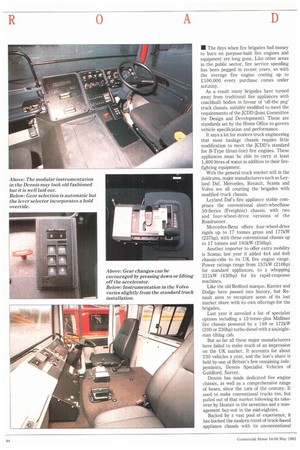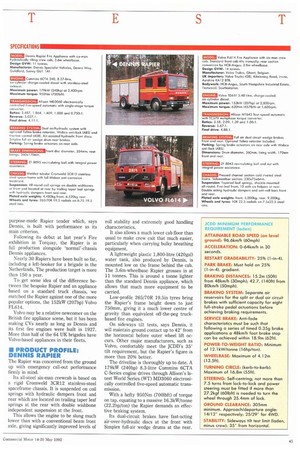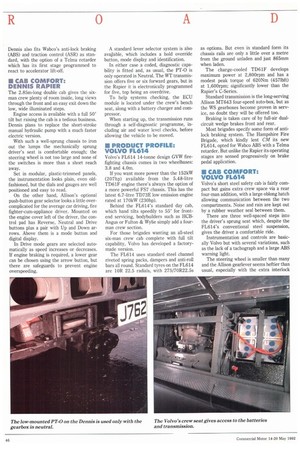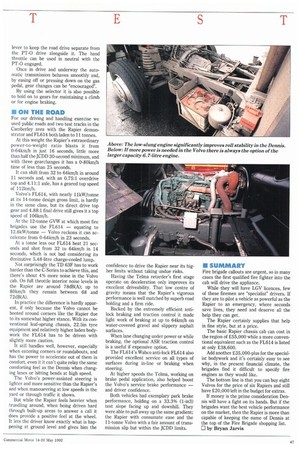• The days when fire brigades had money to burn
Page 46

Page 47

Page 48

Page 49

If you've noticed an error in this article please click here to report it so we can fix it.
on purpose-built fire engines and equipment are long gone. Like other areas in the public sector, fire service spending has been pegged in recent years, so with the average fire engine costing up to £100,000 every purchase comes under scrutiny.
As a result many brigades have turned away from traditional fire appliances with coachbuilt bodies in favour of 'off-the peg' truck chassis, suitably modified to meet the requirements of the JCDD (Joint Committee for Design and Development). These are standards set by the Home Office to govern vehicle specification and performance.
It says a lot for modern truck engineering that most haulage chassis require little modification to meet the JCDD's standard for B-Type (front-line) fire engines. These appliances must be able to carry at least 1,800 litres of water in addition to their firefighting equipment.
With the general truck market still in the doldrums, major manufacturers such as Leyland Daf, Mercedes, Renault, Scania and Volvo are all courting the brigades with modified truck chassis.
Leyland Dais fire appliance stable comprises the conventional short-wheelbase 50-Series (Freighter) chassis, with two and four-wheel-drive versions of the Roadrunner.
Mercedes-Benz offers four-wheel-drive rigids up to 17 tonnes gross and 177kW (237hp), with three conventional chassis up to 17 tonnes and 195kW (256hp).
Another importer to offer extra mobility is Scania; last year it added 4x4 and 6x6 chassis-cabs to its UK fire engine range. Power ratings range from 157kW (210hp) for standard appliances, to a whopping 321kW (430hp) for its rapid-response machines.
Like the old Bedford marque, Karrier and Dodge have passed into history, but Renault aims to recapture some of its lost market share with its own offerings for the brigades.
Last year it unveiled a list of specialist options including a 12-tonne-plus Midliner fire chassis powered by a 149 or 172kW (200 or 230hp) turbo-diesel with a six/eightman tilting cab.
But so far all these major manufacturers have failed to make much of an impression on the UK market. It accounts for about 230 vehicles a year, and the lion's share is held by one of Britain's few remaining independents, Dennis Specialist Vehicles of Guildford, Surrey.
Dennis has made dedicated fire engine chassis, as well as a comprehensive range of buses, since the turn of the century. It used to make conventional trucks too, but pulled out of that market following its takeover by Hestair in the seventies and a management buy-out in the mid-eighties.
Backed by a vast pool of experience, it has bucked the modern trend of truck-based appliance chassis with its unconventional purpose-made Rapier tender which, says Dennis, is built with performance as its main criterion.
Following its debut at last year's Fire exhibition in Torquay, the Rapier is in full production alongside 'normal'-chassis Dennis appliances.
Nearly 30 Rapiers have been built so far, including a left-hooker for a brigade in the Netherlands. The production target is more than 150 a year.
To get some idea of the difference between the bespoke Rapier and an appliance based on a standard truck chassis, we matched the Rapier against one of the more popular options, the 152kW (207hp) Volvo
FI-614.
Volvo may be a relative newcomer on the British fire appliance scene, but it has been making CVs nearly as long as Dennis and its first fire engines were built in 1927. More than half of the 64 UK brigades have Volvo-based appliances in their fleets.
• PRODUCT PROFILE: D ENNIS RAPIER
The Rapier was conceived from the ground up with emergency call-out performance firmly in mind.
Its all-steel six-man crewcab is based on a rigid Cromweld 3CR12 stainless-steel spaceframe chassis. It is suspended on coil springs with hydraulic dampers front and rear which are located on trailing taper leaf springs at the rear with double wishbone independent suspension at the front.
This allows the engine to be slung much lower than with a conventional beam front axle, giving significantly improved levels of roll stability and extremely good handling characteristics.
It also allows a much lower cab floor than usual to make crew exit that much easier, particularly when carrying bulky breathing equipment.
A lightweight plastic 1,800-litre (420gal) water tank, also produced by Dennis, is mounted low on the frame behind the cab. The 3.6m-wheelbase Rapier grosses in at 11 tonnes. This is around a tonne lighter than the standard Dennis appliance, which allows that much more equipment to be carried.
Low-profile 265/70R 19.5in tyres bring the Rapier's frame height down to just 750mm, giving it a much lower centre of gravity than equivalent off-the-peg truckbased fire engines.
On sideways tilt tests, says Dennis, it will maintain ground contact up to 42° from the horizontal before outer wheel lift occurs. Other major manufacturers, such as Volvo, comfortably meet the JCDD's 35° tilt requirement, but the Rapier's figure is more than 20% better.
The driveline is thoroughly up to date. A 179kW (240hp) 8.3-litre Cummins 6CTA C-Series engine drives through Allison's latest World Series (WT) MD3060 electronically controlled five-speed automatic transmission.
With a hefty 950Nm (700lbft) of torque on tap, equating to a massive 16.3kW/tonne (22.2hp/ton) the Rapier demands an effective braking system.
Its dual-circuit brakes have fast-acting air-over-hydraulic discs at the front with Simplex full-air wedge drums at the rear_ Dennis also fits Wabco's anti-lock braking (ABS) and traction control (ASR) as standard, with the option of a Telma retarder which has its first stage programmed to react to accelerator lift-off.
• CAB COMFORT: DENNIS RAPIER
The 2.85m-long double cab gives the sixman crew plenty of room inside, long views through the front and an easy exit down the low, wide illuminated steps.
Engine access is available with a full 50' tilt but raising the cab is a tedious business. Dennis plans to replace the short-stroke manual hydraulic pump with a much faster electric version.
With such a well-sprung chassis to iron out the lumps the mechanically sprung driver's seat is comfortable enough; the steering wheel is not too large and none of the switches is more than a short reach away.
Set in modular, plastic-trimmed panels, the instrumentation looks plain, even oldfashioned, but the dials and gauges are well positioned and easy to read.
On the other hand, Allison's optional push-button gear selector looks a little overcomplicated for the average car driving, fire fighter-cum-appliance driver. Mounted on the engine cover left of the driver, the control pad has Reverse, Neutral and Drive buttons plus a pair with Up and Down arrows. Above them is a mode button and digital display.
In Drive mode gears are selected automatically as speed increases or decreases. If engine braking is required, a lower gear can be chosen using the arrow button, but there are safeguards to prevent engine overspeeding. A standard lever selector system is also ava,llable, which includes a hold override button, mode display and identification.
In either case a coded, diagnostic capability is fitted and, as usual, the PT-0 is only operated in Neutral. The WT transmission offers five or six forward gears, but in the Rapier it is electronically programmed for five, top being an overdrive.
To help systems checking, the ECU module is located under the crew's bench seat, along with a battery charger and compressor.
When starting up, the transmission runs through a self-diagnostic programme, including air and water level checks, before allowing the vehicle to be moved.
• PRODUCT PROFILE: VOLVO FL614
Volvo's FL614 14-tonne design GVW firefighting chassis comes in two wheelbases: 3.8 and 4.0m.
If you want more power than the 152kW (207hp) available from the 5.48-litre TD61F engine there's always the option of a more powerful FS7 chassis. This has the latest 6.7-litre TD73E low emission engine rated at 170kW (230hp).
Behind the FL614's standard day cab, which hand tilts speedily to 55° for frontend servicing, bodybuilders such as HCBAngus or Fulton & Wylie simply add a fourman crew section.
For those brigades wanting an all-steel six-man crew cab complete with full tilt capability, Volvo has developed a factorymade version.
The FL614 uses standard steel channel riveted spring packs, dampers and anti-roll bars all round. Standard tyres on the FL614 are lOR 22.5 radials, with 275/70R22.5s as options. But even in standard form its chassis rails are only a little over a metre from the ground unladen and just 865mm when laden.
The charge-cooled TD61F develops maximum power at 2,800rpm and has a modest peak torque of 620Nm (4571MO at 1,600rpm; significantly lower than the Rapier's C-Series.
Standard transmission is the long-serving Allison MT643 four-speed auto-box, but as the WS gearboxes become proven in service, no doubt they will be offered too.
Braking is taken care of by full-air dualcircuit wedge brakes front and rear.
Most brigades specify some form of antilock braking system. The Hampshire Fire Brigade, which kindly lent CM its new FL614, opted for Wabco ABS with a Telma retarder. But unlike the Rapier its operating stages are sensed progressively on brake pedal application.
• CAB COMFORT: VOLVO FL614 Volvo's short steel safety cab is fairly compact but gains extra crew space via a rear four-man addition, with a large oblong hatch allowing communication between the two compartments. Noise and rain are kept out by a rubber weather seal between them.
There are three well-spaced steps into the driver's sprung seat which, despite the FL614's conventional steel suspension, gives the driver a comfortable ride.
Instrumentation and controls are basically Volvo but with several variations, such as the lack of a tachograph and a large ABS warning light.
The steering wheel is smaller than many and the Allison gearlever seems heftier than usual, especially with the extra interlock lever to keep the road drive separate from the PT-0 drive alongside it. The hand throttle can be used in neutral with the PT-0 engaged.
Once in drive and underway the automatic transmission behaves smoothly and, by easing off or pressing down on the gas pedal, gear changes can be "encouraged".
By using the selector it is also possible to hold on to gears for maintaining a climb or for engine braking.
• ON THE ROAD
For our driving and handling exercise we used public roads and two test tracks in the Camberley area with the Rapier demonstrator and FL614 both laden to 11 tonnes.
At this weight the Rapier's extraordinary power-to-weight ratio blasts it from 0-64km/h in just 16 seconds, little more than half the JCDD 30-second minimum, and with three gearchanges it has a 0-80km/h time of less than 25 seconds.
It can shift from 32 to 64km/h in around 11 seconds and, with an 0.75:1 overdrive top and 4.11:1 axle, has a geared top speed of 112km/h.
Volvo's FL614, with nearly 11kW/tonne at its 14-tonne design gross limit, is hardly in the same class, but its direct drive top gear and 4.88:1 final drive still gives it a top speed of 106km/h.
At the 12-tonne GVW at which most fire brigades use the FL614 — equating to 12.6kW/tonne — Volvo reckons it can accelerate from 0-64km/h in 23 seconds.
At a tonne less our FL614 beat 21 seconds and shot from 32 to 64km/h in 14 seconds, which is not bad considering its diminutive 5.48-litre charge-cooled lump.
Not surprisingly the TD 63F has to work harder than the C-Series to achieve this, and there's about 4% more noise in the Volvo cab. On full throttle interior noise levels in the Rapier are around 78dB(A); up to 80km/h they remain between 68 and 72dB(A).
In practice the difference is hardly apparent, if only because the Volvo cannot be hooted around corners like the Rapier due to its somewhat higher stance. With its conventional leaf-sprung chassis, 22.5in tyre equipment and relatively higher laden bodywork the FL614 has to be driven with slightly more caution.
It still handles well, however, especially when entering corners or roundabouts, and has the power to accelerate out of them in comfort, even it it can't quite relay the same comforting feel as the Dennis when changing lanes or hitting bends at high speed.
The Volvo's power-assisted steering is lighter and more sensitive than the Rapier's and when manouevring at low speeds in the yard or through traffic it shows.
But while the Rapier feels heavier when trundling around, when being driven hard through built-up areas to answer a call it does provide a positive feel at the wheel. It lets the driver know exactly what is happening at ground level and gives him the confidence to drive the Rapier near its higher limits without taking undue risks.
Having the Telma retarder's first stage operate on deceleration only improves its excellent driveability. That low centre of gravity means that the Rapier's vigorous performance is well matched by superb road holding and a firm ride.
Backed by the extremely efficient antilock braking and traction control it made light work of braking at up to 64km/h on water-covered gravel and slippery asphalt surfaces.
When lane changing under power or while braking, the optional ASR traction control is a useful if expensive option.
The FL614's Wabco anti-lock FL614 also provided excellent service on all types of surfaces during in-line or braking when steering.
At higher speeds the Telma, working on brake pedal application, also helped boost the Volvo's service brake performance — and driver confidence.
Both vehicles had exemplary park brake performance, holding on a 33.3% (1-in3) test slope facing up and downhill. They were able to pull away up the same gradient; the Rapier with consumate ease and the 11-tonne Volvo with a fair amount of transmission slip but within the JCDD limits.
• SUMMARY
Fire brigade callouts are urgent, so in many cases the first qualified fire fighter into the cab will drive the appliance.
While they will have LGV licences, few of these firemen are "specialist" drivers. If they are to pilot a vehicle as powerful as the Rapier to an emergency, where seconds save lives, they need and deserve all the help they can get.
The Rapier certainly supplies that help in fine style, but at a price.
The basic Rapier chassis cab can cost in the region of £55,000 while a more conventional equivalent such as the FL614 is listed at only £38,600.
Add another £35,000-plus for the specialist bodywork and it's certainly easy to see why, in the present financial climate, the brigades find it difficult to specify fire engines as they would like.
The bottom line is that you can buy eight Volvos for the price of six Rapiers and still have £20,000 left in the budget for extras.
If money is the prime consideration Dennis will have a fight on its hands. But if the brigades want the best vehicle performance on the market, then the Rapier is more than capable of keeping the name of Dennis at the top of the Fire Brigade shopping list. O by Bryan Jarvis




































































































